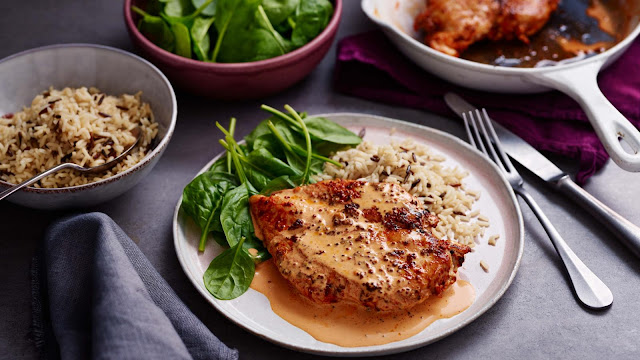Today I am sharing a low carb/keto recipe by Gino D'Campo who says "are you looking for a delicious salmon recipe with a difference? If you are, you’ve found it! Here’s my wrapped salmon with Dijon mustard & mascarpone sauce for you to enjoy.
For many people, salmon is the king of fish – it has a firm, meaty texture and a beautiful pink colour. It’s really versatile, too – it can be baked, poached, steamed, fried or flaked into stir-fries, pasta or risotto. It’s known as a brain food because of its high Omega 3 content, as well as being rich in vitamin D and minerals. This is a delicious way to get all the family eating fish – creamy, comforting and delicious."
Ingredients
Serves Four
1 Courgette (zucchini), Trimmed
400g, Cut Into 4 Pieces Skinless Salmon Fillet
40g Salted Butter
100ml Hot Vegetable Stock
1 Teaspoon Dijon Mustard
50g (Reduced Fat) Mascarpone Cheese
1 Tablespoon Fresh Dill, Finely Chopped
1/2 Teaspoon Garlic Salt
To Taste Salt
To Taste Freshly Ground Black Pepper
400g, Cut Into 4 Pieces Skinless Salmon Fillet
40g Salted Butter
100ml Hot Vegetable Stock
1 Teaspoon Dijon Mustard
50g (Reduced Fat) Mascarpone Cheese
1 Tablespoon Fresh Dill, Finely Chopped
1/2 Teaspoon Garlic Salt
To Taste Salt
To Taste Freshly Ground Black Pepper
Method
1. Preheat the oven to 200ºC/gas mark 6.
2. Using a potato peeler, slice 8 wide ribbons from the courgette (zucchini) lengthways and set aside.
3. Lightly season each salmon fillet with salt and wrap 2 courgette ribbons around each fillet. Transfer the wrapped salmon to a baking tray measuring about 25 x 35cm and evenly dot the butter over. Transfer to the oven and bake for 18 minutes.
4. Dice the remaining courgette and put into a small saucepan. Add the vegetable stock, Dijon mustard, mascarpone cheese, dill and garlic salt and stir all together. Place the saucepan over a low heat and gently cook for 10 minutes, stirring occasionally with a wooden spoon. Make sure that the sauce doesn’t boil otherwise it will split.
5. Remove the salmon from the oven and arrange on a serving platter. Pour the mascarpone sauce over and around salmon.
6. Season with black pepper and serve immediately with vegetables of your choice.
Gino's Tip
Bake the salmon parcels seam side down to help prevent the parcels unravelling.
Nutrition Per Serving
2. Using a potato peeler, slice 8 wide ribbons from the courgette (zucchini) lengthways and set aside.
3. Lightly season each salmon fillet with salt and wrap 2 courgette ribbons around each fillet. Transfer the wrapped salmon to a baking tray measuring about 25 x 35cm and evenly dot the butter over. Transfer to the oven and bake for 18 minutes.
4. Dice the remaining courgette and put into a small saucepan. Add the vegetable stock, Dijon mustard, mascarpone cheese, dill and garlic salt and stir all together. Place the saucepan over a low heat and gently cook for 10 minutes, stirring occasionally with a wooden spoon. Make sure that the sauce doesn’t boil otherwise it will split.
5. Remove the salmon from the oven and arrange on a serving platter. Pour the mascarpone sauce over and around salmon.
6. Season with black pepper and serve immediately with vegetables of your choice.
Gino's Tip
Bake the salmon parcels seam side down to help prevent the parcels unravelling.
Nutrition Per Serving
Fat 26g Carbs 2g Fibre 1g Protein 23g
From an original idea seen here
From an original idea seen here
Happy Eating, Bon Appetit and Mangiare Felice !
Dear reader, this blog is presented in a magazine style - we hope something for everyone. You will find a variety of articles, studies, thoughts, photographs, cartoons, music and recipes!
However, not all the food and recipes ideas featured in this blog may be suitable for you. If you may have any food allergies, or underlying health issues these must always be taken into account. If you are a diabetic and not sure how certain foods may affect your blood sugars, test is best, i.e. use your meter.
All the best Jan






























